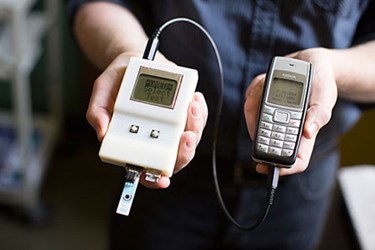Handheld Device Promises To Deliver Inexpensive Diagnostics To Developing World
By Chuck Seegert, Ph.D.

When most people go to the hospital, the laboratory analysis of various tests is taken for granted. In many developing countries, however, this is not the case, and even the most basic laboratory tests may not be available.
To put these diagnostic tools into the hands of third world healthcare professionals, researchers at Harvard’s School of Engineering and Applied Sciences have developed a cheap, portable detector that interfaces with a cellphone. The device can be used to do a variety of diagnostic tests such as diabetes monitoring and malaria detection.
In resource limited environments there is a need to provide various forms of electrochemical testing, one of the most prevalent analytical methods. In addition, transmitting the test results via some form of universal data transfer is necessary for communicating test results. With that in mind, the research team set out to design a device that would meet both of these requirements in such a way that it would be easy-to-use for many users.
"We designed it to be as close as possible to a glucose meter, because that's familiar to people,” said Alex Nemiroski, a postdoctoral fellow in the lab of Flowers University Professor George Whitesides, in a recent Harvard Gazette article. “There are two buttons. Select the test and press 'go.' It should be as much of a no-brainer as possible."
Nemiroski served as the lead author of the paper describing the work, which was released recently in the Proceedings of the National Academy of Sciences.
Electrochemical testing measures certain characteristics of fluids by passing voltages and currents through them. This method requires some small amounts of reagents to be used with the test sample, which is similar to what is performed in the clinic now, albeit in much smaller quantities. The device, while being very compact, provides a mixing function through vibration.
For a device that is about the size of a pack of playing cards, it boasts a lot of diagnostic capabilities. With the current device, it is possible to measure glucose levels in the blood, heavy metals that may be in drinking water, sodium concentration in urine, and the presence of malarial antigens for clinical testing. Nemiroski also plans to add more functionalities to the next generation of the device.
Transmitting this data was another important requirement, as the device needed to work with any cellphone or network that might be available in the field. While the developed world can connect to the web in many ways, developing countries often have limited options when it comes to network connectivity. In order to achieve broad connectivity, the researchers went back to an older, but reliable form of data transfer: audio signals sent over the voice channel of a phone.
The multi-function capabilities of the new handheld instrument, along with its affordability and ability to connect to nearly any network, may allow sophisticated diagnostic testing to be performed in many areas where it was previously unavailable. According to the Gazette , the device costs about $25 to manufacture and has already begun field testing in India.
